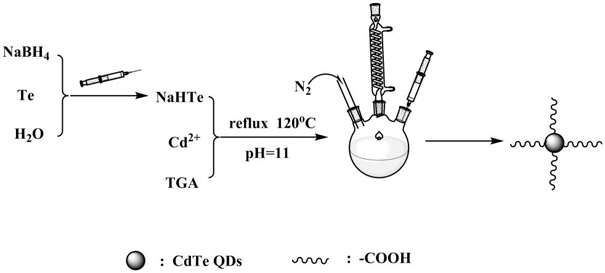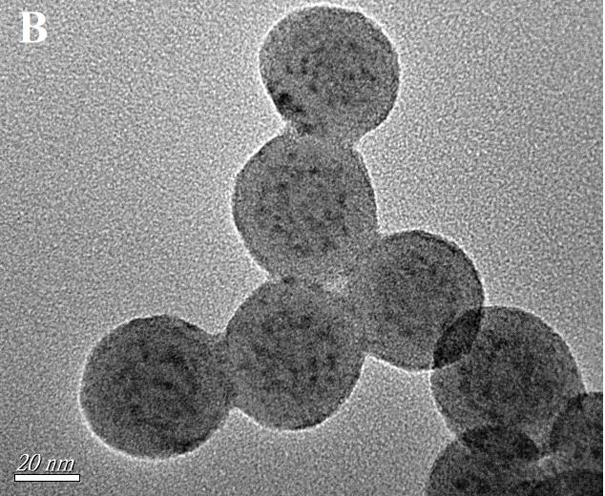A Fluorescent Analysis Method Using Dual Emission Ratio Fluorescent Quantum Dot Probes for Detecting Dopamine
A ratiometric fluorescent probe and ratiometric fluorescence technology, applied in the field of preparation of environmental functional materials, can solve problems such as complex preparation, long time consumption, and harmfulness to organisms
- Summary
- Abstract
- Description
- Claims
- Application Information
AI Technical Summary
Problems solved by technology
Method used
Image
Examples
Embodiment 1
[0030] (1) Add 60.6mg of sodium borohydride (NaBH4) and 51.04mg of tellurium powder into the centrifuge tube, use a needle to pierce a small hole on the cover of the centrifuge tube to discharge excess hydrogen from the reaction, and then add 1.5mL of double distilled water The solid was completely dissolved; the centrifuge tube was placed in an ultrasonic machine for ultrasonic reaction for 2 hours, and the final white transparent liquid was the required precursor NaHTe solution.
[0031](2) Under the condition of passing nitrogen and removing oxygen, inject the precursor NaHTe solution obtained in step (1) into cadmium chloride hydrate (CdCl2 2.5 H2O) aqueous solution, wherein 28.34 mg of CdCl2·2.5H2O2 was added, and the mixed solution was refluxed at 120° C. for 85 h under nitrogen protection conditions to obtain the required red fluorescent quantum dots.
[0032] (3) Add 800 μL of red fluorescent quantum dots obtained in step (2) to a mixed solution of 3.2 mL of n-hexanol,...
Embodiment 2
[0040] (1) Add 75.7mg of sodium borohydride (NaBH4) and 51.04mg of tellurium powder into the centrifuge tube, use a needle to pierce a small hole on the cover of the centrifuge tube to discharge excess hydrogen from the reaction, and then add 1.5mL of double distilled water The solid was completely dissolved; the centrifuge tube was placed in an ultrasonic machine for ultrasonic reaction for 2 hours, and the final white transparent liquid was the required precursor NaHTe solution.
[0041] (2) Under the condition of passing nitrogen and removing oxygen, the precursor NaHTe solution obtained in step (1) is injected into cadmium chloride hydrate (CdCl2 2.5 H2O) aqueous solution, wherein 152.23 mg of CdCl2·2.5H2O was added, and the mixed solution was refluxed at 120° C. for 85 h under nitrogen protection to obtain the required red fluorescent quantum dots.
[0042] (3) Add 800 μL of red fluorescent quantum dots obtained in step (2) to a mixed solution of 4.0 mL of n-hexanol, 15.2...
Embodiment 3
[0050] (1) Add 90.9mg of sodium borohydride (NaBH4) and 51.04mg of tellurium powder into the centrifuge tube, use a needle to pierce a small hole on the cover of the centrifuge tube to discharge excess hydrogen from the reaction, and then add 1.5mL of double distilled water The solid was completely dissolved; the centrifuge tube was placed in an ultrasonic machine for ultrasonic reaction for 2 hours, and the final white transparent liquid was the required precursor NaHTe solution.
[0051] (2) Under the condition of nitrogen deoxygenation, the precursor NaHTe solution obtained in step (1) is injected into cadmium chloride hydrate (CdCl2 2.5H2O) in the presence of 133 μL thioglycolic acid (TGA) for deoxygenation through nitrogen. ) aqueous solution, wherein 182.67 mg of CdCl2·2.5H2O was added, and the mixed solution was refluxed at 130° C. for 72 hours under the protection of nitrogen to obtain the required red fluorescent quantum dots.
[0052] (3) Add 800 μL of red fluorescen...
PUM
 Login to View More
Login to View More Abstract
Description
Claims
Application Information
 Login to View More
Login to View More - R&D
- Intellectual Property
- Life Sciences
- Materials
- Tech Scout
- Unparalleled Data Quality
- Higher Quality Content
- 60% Fewer Hallucinations
Browse by: Latest US Patents, China's latest patents, Technical Efficacy Thesaurus, Application Domain, Technology Topic, Popular Technical Reports.
© 2025 PatSnap. All rights reserved.Legal|Privacy policy|Modern Slavery Act Transparency Statement|Sitemap|About US| Contact US: help@patsnap.com



